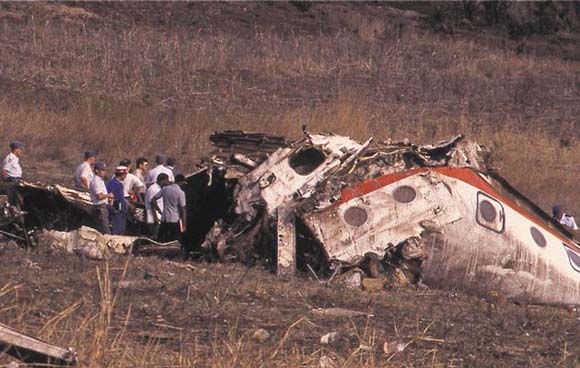Mozambique's International
Relations with South Africa
Dossier MZ-0007, part 10
![]()
![]()
10. Nkomati: a Dead Letter by 1986,
and Samora Dies at Mbuzini

Above: The wreckage of the presidential aircraft on the ground at Mbuzini. For MHN’s resources on the Mbuzini disaster – including several web pages of downloadable material on the various inquiries as well as historical context on the crisis of October 1986, click here
The South African apartheid regime’s violations of Nkomati continued unrelentingly throughout 1986, to the dismay of the Mozambicans, reaching a climax in the regional crisis of October, during which President Samora Machel was killed in the air disaster at Mbuzini, with South African involvement widely suspected. But even before that traumatic event, and within two years of its signing, the agreement was affectively a dead letter. Indeed, in the Zimbabwean news magazine Moto no.43 (1986), the Maputo-based journalist Paul Fauvet was commenting that
... seldom has a solemn treaty fallen into disrepute as rapidly as the Nkomati Accord. Mozambique signed in the belief that the South African government was serious and would drop its support for ... the MNR. But clear evidence of South African violations of the Accord ... was available by September 1984, and the full extent of South African duplicity was revealed when Mozambican and Zimbabwean forces captured the Casa Banana, headquarters of the MNR at Gorongosa...
Diaries and notebooks found at Casa Banana showed that the South African armed forces had never intended to respect the Nkomati Accord. They pumped in arms and ammunition to the MNR immediately before the signing ceremony and later in 1984 mounted a major rescue operation when the MNR was on the verge of. defeat. MNR leaders were ferried back and forth by South African planes between Gorongosa and the Transvaal. In South Africa, the MNR was promised full support at meetings with the top military brass, including the then head of the armed forces himself, General Constand Viljoen.
A South African junior minister, Louis Nel ... clandestinely visited Casa Banana on three occasions in mid-1985. The MNR even took photographs of this little adventure and had some of them published later in right wing Portuguese newspapers.
... The joint security commission established under the agreement has ceased to operate: the South Africans blamed this on Mozambican withdrawal. But as Mozambican Security Minister Sergio Vieira put it: "when the other party, in a deliberate, premeditated and large scale way, decides not to observe the accord, it is obvious that the joint security commission becomes impotent and cannot function."
Relations between the governments of Mozambique and South Africa were at an all-time low point in the weeks leading up to 19 October 1986, with the apartheid regime resorting to increasingly explicit warnings and threats if Mozambique did not bend to its will.
Apart from two main protagonists, the governments of apartheid South Africa and revolutionary Mozambique, other participants in the crisis included the African National Congress (ANC), the Frontline States, Malawi and Zaire. Pressure from the Frontline States on President Hastings Banda of Malawi in September resulted indirectly in a massive infiltration of MNR into central Mozambique; a landmine explosion inside South Africa that injured some SADF personnel enraged the apartheid regime, which suspended the recruitment of Mozambican labour for the South African mines; the possibility of a direct South African military intervention in Mozambique began to appear real, as threats and warnings escalated; and the Frontline States, far from backing down, began to exert pressure on President Mobutu sese Seko of Zaire, as they had done with Banda, to end his support for the UNITA rebels in Angola, another of «apartheid’s contra» movements. For more details, see the MHN webpage The October Crisis, here.
By year's end Joaquim Chissano had assumed the presidency. For Mozambique, the economic and developmental costs of this struggle were enormous. Indeed, on 17 November the Zimbabwean daily newspaper The Herald reported that in the eleven years since independence, South African aggression, direct and indirect, had cost the Mozambican economy an estimated US$5 billion.
MHN Resources
Consolidated Downloadable Zipped Files
Click on the yellow folder image below to download a zipped file of the tenth of a series of dossiers on South Africa-Mozambique relations. The archive covers the year 1986, and contains 78 documents. New items will be added from time to time: this edition of the dossier is dated 23 October 2021.
![]()



![Aluka: Struggles for Freedom [subscription required] Struggles for Freedom](imgs/aluka_200.png)


